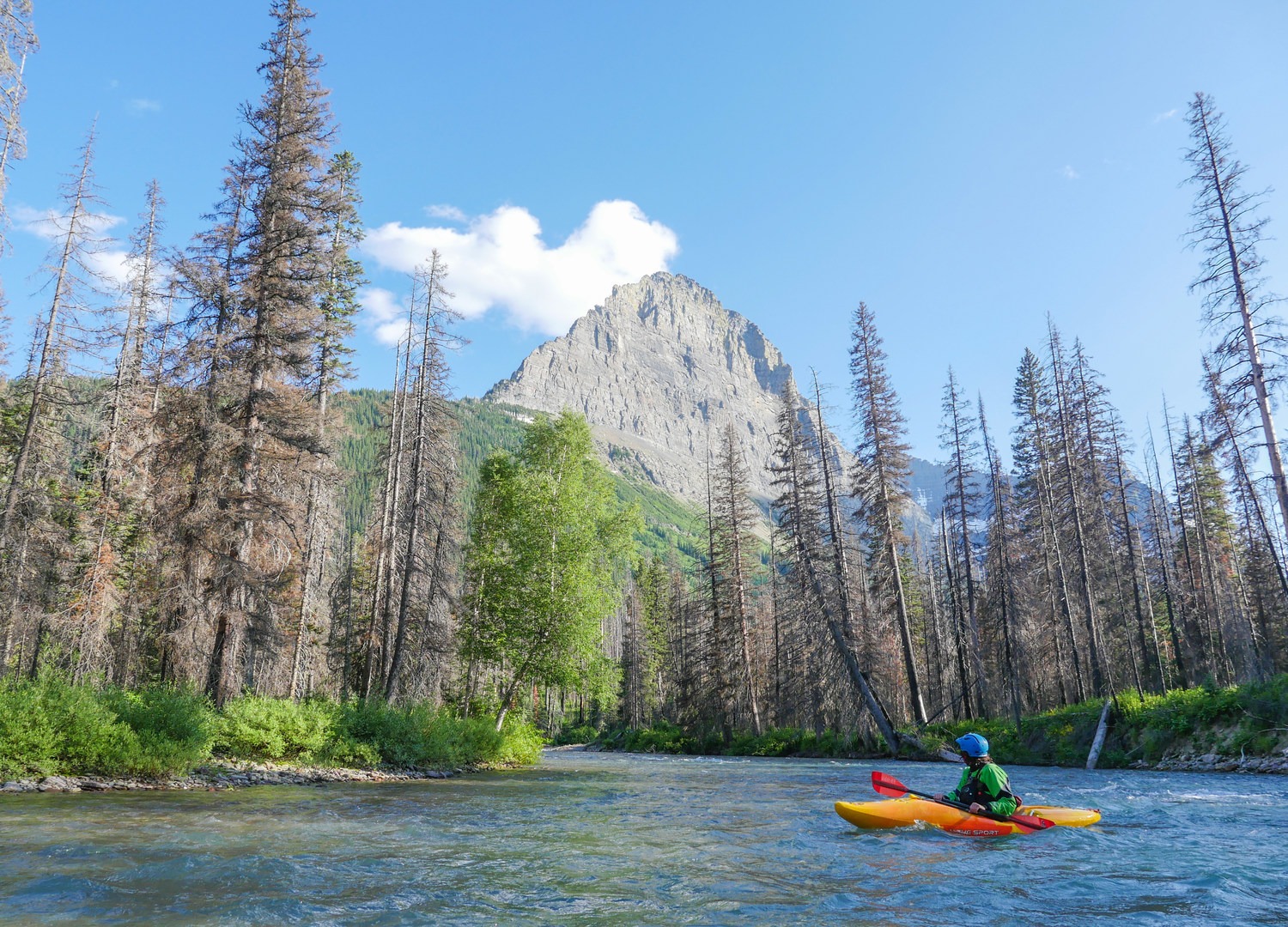You are here
Located in Glacier National Park, the upper reaches of Siyeh Creek are often enjoyed by hikers who use the Piegan Pass Trail. The sections of the creek downstream of Siyeh Bend on the Going-to-the-Sun Road, however, can only be enjoyed by those with whitewater crafts. There is no trail that parallels the creek until the Continental Divide Trail meets back up with the creek after the confluence with Reynolds Creek.
Paddlers can park vehicles and put in at Siyeh Bend. If desired, paddlers may hike up a little ways on Piegan Pass Trail to put in above the tunnel (which is runnable) under the Going-to-the-Sun Road. Below the tunnel, and depending on snow pack, paddlers may find themselves having to portage an ice bridge covering the creek. It is easiest to portage on the right side of the creek.
It is about 1.8 miles from Siyeh Bend to the confluence of Reynolds Creek. The creek is a fun mix of bedrock slides, ledges, and easy portages. At around 0.5 mile, you will reach the first long bedrock slide. Over the next half-mile or so, the canyon will gradually steepen, so scout and pick which drops you wish to run. Keep an eye out for stromatolites (cabbage-like fossils located in the bedrock on Siyeh Creek). These formations are a laminated rock formed by the growth of blue-green algae (cyanobacteria). Stromatolites are Earth's oldest of fossils, and they are intriguing because they are a visual portal into the earliest emergence of life on earth.
Just before the confluence with Reynolds, the steepest part of Siyeh drops over bedrock shelves, and you can view Heavy Runner Mountain. You can portage this section on the left side of the river, put back in, and pick off a final slide before entering a meadow where Reynolds and Siyeh converge and become Reynolds Creek.
Once in the meadow, there is about a mile of flat water and intermingled wood portaging. Be cautious in this section; it is known bear habitat, and since there is no road or trail nearby, the bears in the area are not accustomed to being startled by human visitors. Move with purpose, make your presence known, and get back on the water quickly.
After the flat meadow, Reynolds becomes forested again and gradually picks up and turns into a gorge. In the gorge are a series of ledges that end in a waterfall. Scouting the gorge is easiest on the right side of the river. There is a large log in the second part of the gorge, which is a fun looking slide—if it did not have a wood hazard in it—just above the final waterfall. This slide can be portaged by running the ledges upstream, catching an eddy on river left, and portaging left, then returning back to the river in a pool just above the final waterfall, which you can then scout and/or portage.
After the gorge, Reynolds Creek opens back up into pool-drop style of bedrock ledges and rapids. At GPS coordinates 48.6694, -113.6442, get on river left to scout and portage a series of very serious drops into a bedrock crack. You may return to Reynolds below this series of drops or get onto the Continental Divide Trail and put back in at Deadwood Falls (48.6667, -113.637). If you choose to put back in just below the large crack drop, scout carefully, because there are some more serious drops not too far downstream.
Below Deadwood Falls, and just past a footbridge over Reynolds Creek, there will be a few more bedrock ledges that are worth a scout. Then, a short distance downstream, Reynolds meets the St. Mary's River at a sharp bend. Around 0.5 mile downstream of the confluence is a series of ledges that can be scouted on the right. The next drop is a more serious ledge into a slide. Take a look on river right. The rapid looks fun, but a potentially consequential current pushes into a deep undercut on river left. Following this drop, pop out around 48.668, -113.6163, where you can portage St. Mary's Falls. Get back in just downstream of the bridge over St. Mary's Falls.
In a short distance, St. Mary's River meets St. Mary's Lake. Paddle following the left shoreline, take out at the boat dock (48.6756, -113.5942), and hike up Baring Creek Trail. Take a left when the trail meets a junction and follow the trail for 0.2 mile until you reach the parking area where Going-to-the-Sun Road crosses Baring Creek just downstream of Sunrift Gorge.
Flow Information
- 70 cfs is hilariously low. Kayaks have run it around 150 cfs, which is low but good.
- 200 to 300 cfs is a medium flow.
- 400 and over is high, and upper flows for what is runnable are unknown.
Last Words
- You will need to obtain an invasive species permit from the park and have an invasive species boat check by a park ranger each time you enter the park. Please plan for additional time to do this during your visit, and please be respectful of the invasive species requirements and regulations so that the ability to kayak in the park is not compromised.
- Carry bear spray. The area is known grizzly habitat.
- Check for wood each year and scout thoroughly.
- Going-to-the-Sun Road is closed annually and opens when snow has been plowed. If Going-to-the-Sun Road is not cleared to Siyeh Bend, you can access Siyeh Creek above St. Mary's Lake. Enter the park on the east side, drive to St. Mary's lake, park where the road is open, and hike up to Siyeh Bend. Ask at the ranger station for road closure information prior to your trip.
Logistics + Planning
Current Weather: Powered by Dark Sky























Comments
Sign In and share them.